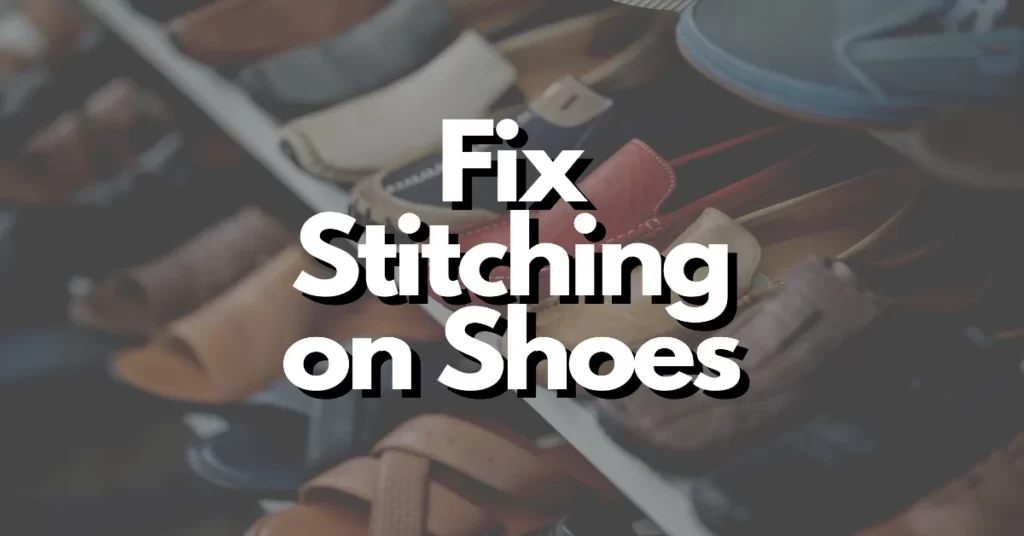Damaged or loose stitching on your shoes can not only be unsightly, but it can also affect the comfort, fit, and durability of your footwear. Whether you have a favorite pair of sneakers, boots, or dress shoes, knowing how to fix stitching on your shoes can save you money and extend the life of your beloved footwear.
In this blog post, we will explore common methods and techniques for fixing stitching on shoes, from DIY solutions to professional repairs, to help you keep your shoes in tip-top condition.
Common Shoe Stitching Problems
Shoes are an essential part of our daily wardrobe, but they can sometimes encounter stitching problems that affect their comfort, durability, and appearance. Some common shoe stitching problems include loose stitches, frayed threads, broken stitches, mismatched stitching, and uneven stitches.
These issues can occur in various areas of the shoe, such as the upper, sole, heel, or toe, and they can result from wear and tear, poor construction, or accidental damage. Addressing these stitching problems in a timely manner is important to prevent further damage and extend the lifespan of the shoes.
Tools and Materials for Fixing Shoe Stitching
Fixing shoe stitching problems requires some basic tools and materials.
These may include a needle, thread (preferably matching the color and material of the original stitching), scissors, a thimble (to protect your fingers from getting pricked), a seam ripper (to remove damaged stitches), a shoe repair adhesive (for bonding detached parts), and a shoe repair hammer (for tapping down stitches or securing them in place).
Additionally, you may need specific tools or materials depending on the type of stitching used in the shoes, such as a sewing awl for repairing hand-stitched shoes, or a sewing machine for fixing machine-stitched shoes.
Overview of Fixing Shoe Stitching Steps
The process of fixing shoe stitching problems typically involves several steps. First, you need to assess the extent of the damage and determine the appropriate repair method.
This may involve removing the damaged stitches using a seam ripper, applying adhesive to reattach detached parts, or reinforcing weak or frayed stitches with additional stitching. Next, you need to carefully stitch the damaged area using a needle and thread, making sure to match the original stitching pattern and tension for a seamless repair.
Finally, you may need to trim excess thread, tap down stitches with a shoe repair hammer to ensure they lie flat, and apply a shoe repair adhesive to secure the repaired area.
Tips for a Successful Shoe Stitching Repair
Repairing shoe stitching requires attention to detail and some basic sewing skills. Here are some tips for a successful shoe stitching repair:
- Use the right type of thread: Choose a thread that matches the color and material of the original stitching, and make sure it is strong and durable enough to withstand the wear and tear of shoes.
- Follow the original stitching pattern: Pay close attention to the original stitching pattern and tension, and try to replicate it as closely as possible for a seamless repair. This will ensure that the repaired area looks natural and does not stand out.
- Reinforce weak stitches: If you notice weak or frayed stitches in other areas of the shoe, reinforce them with additional stitching to prevent further damage.
- Trim excess thread: After stitching, trim excess thread close to the surface of the shoe to give the repair a clean and professional finish.
- Use shoe repair adhesive when necessary: Shoe repair adhesive can be used to bond detached parts or secure stitches in place, especially in areas that are difficult to stitch or where additional reinforcement is needed.
When to Seek Professional Help for Shoe Stitching Repair
While minor shoe stitching problems can be repaired at home with basic sewing skills and tools, some issues may require professional help.
If you are not confident in your sewing skills, or if the stitching problem is complex or extensive, it is best to seek the assistance of a professional shoe repair service. They have the expertise, specialized tools, and materials to handle various shoe stitching repairs effectively and ensure a quality and durable result.
Additionally, attempting to repair shoes with complex stitching or delicate materials without proper knowledge and experience may result in further damage, and it may be more cost-effective to seek professional help from the outset.
Conclusion
In conclusion, fixing stitching on your shoes is a practical skill that can help you prolong the life of your footwear and keep them looking great. With the right tools, materials, and techniques, you can achieve professional-looking results and enjoy well-maintained shoes for longer.
If you’re not comfortable with DIY repairs, or if the damage is extensive, it’s always best to seek professional help from a cobbler or shoe repair shop. Taking care of your shoes by fixing stitching issues promptly can help you save money, reduce waste, and ensure that your favorite footwear remains in good condition for years to come.

